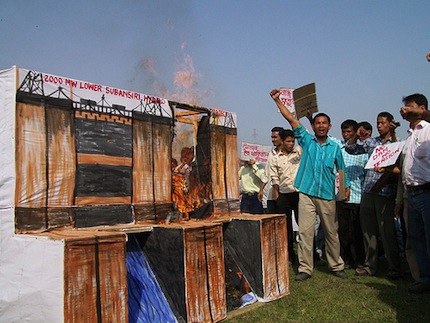In a positive move last month, Assam chief minister Tarun Gogoi announced an expert panel has suggested additional safety measures in the construction of the stalled Subansiri Lower Hydroelectric Project.
The 2,000 megawatt dam is being built by the state-owned National Hydroelectric Power Corporation (NHPC) on the lower reaches of the Subansiri, a tributary of the Brahmaputra, on the border of Assam and Arunachal Pradesh. It is the largest dam in India now under construction.
The controversial project has been stalled for almost two years now because of massive protests in Assam by local people and the farmers’ organisation Krishak Mukti Sangram Samiti.
The expert review panel raised concerns about flaws in the dam design and earthquake risks. NHPC have agreed to implement the recommendations of the Joint Steering Committee to mitigate the downstream impact at a cost of about Rs 470 crore. Social activist from Assam K.K Chatadhara argues this is not enough. “This is a political announcement and it will not work in reality,” he says.
The Subansiri dam is being touted as “another chapter of environment subversion in Northeast India” by the South Asia Network on Dams, Rivers and People (SANDRP). The organisation recently sent a letter to the Expert Appraisal Committee (EAC) on River Valley and Hydroelectric Projects criticising on the quality of the interim report on the basin-wise Environmental Impact Assessment (EIA) of the Subansiri Sub-basin.
“EIAs are instruments to fulfil legal requirements and are often manipulated and tailored to suit [the company’s] needs,” says Chatradhara. “It is a huge task to do a basin study of such a huge catchment area like the Subansiri which requires at least 30 years of metereological and hydrological data. The basin study will help them garner international funds to build the dams.”
Back home, however, people are not really worried about small clauses in a report. K K Chatradhara, based in Gogamukh in Assam’s Dhemaji district, has been part of a movement called People’s Movement for Subansiri and Bramhmaputra Valley for the past 12 years. He says, “SANDRP has raised some vital points analysing the report, [but] they should have also mentioned that that there should be no large dams on the Subansiri. We will continue our struggle against the construction of mega hydel projects as we have already seen a lot of devastation caused by such dams.”
Hailing from the Ahom community, Chatradhara has grown up by the banks of the river Subansiri. Before the protests started, the dam project was handed over to the NHPC by the Brahmaputra Board in 2000 without any environmental clearance. “Finally, we have been able to hold the project for two years. We, the people on the ground feel that the struggle against the Lower Subansiri is going to be a long one,” he adds.
The basin wide environmental impact assessment report is of very poor quality, says Chatradhara. He points out some basic inconsistencies of the report: “The length of the river is more than 500 km from its source to its confluence at the Brahmaputra. But the report states it is 375 km.” The report also fails to mention many small and large-scale hydro projects planned in the basin.
Partha J. Das, an environmental researcher at Aaranyak, a Guwahati based NGO, says, “The Subansiri dam issue has reached such a stage that nobody can escape. At least the paper work should be done properly and all the gaps and lacunaes fixed. The critique of the interim report should be reviewed by the Ministry of Environment and Forests and if found true, they should repeat some of the exercises. This is an important document as the future of all hydro-electric projects are dependent on it.”
However, Das also feels that any critique must be done by an acknowledged expert in the field. The people critiquing the report should be experts in their field. “The paperwork has to be perfect,” adds Das.
Activists in the northeast now feel that is a need for a united forum to protest against the construction of big dams. Vijay Taram, spokesperson for the Forum for Siang Dialogue in Arunachal Pradesh says nobody is protesting against the construction of a hydel project on the Subansiri on the Arunachal side as it will not directly submerge cultivated or cultivable lands. “We are not activists but indigenous people fighting for our rights over our land, water and life. We are contemplating on working on a united forum for all people who will be affected by the construction of mega dams over the main rivers which are our lifeline,” he adds.
Teresa Rehman is Managing Editor, www.thethumbprintmag.com
